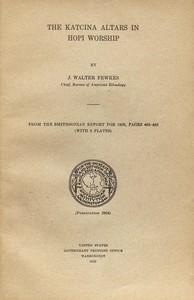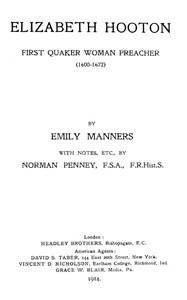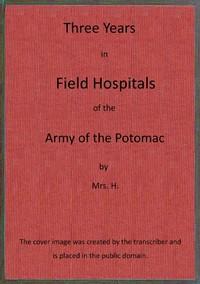|
|
Read this ebook for free! No credit card needed, absolutely nothing to pay.Words: 119850 in 56 pages
This is an ebook sharing website. You can read the uploaded ebooks for free here. No credit cards needed, nothing to pay. If you want to own a digital copy of the ebook, or want to read offline with your favorite ebook-reader, then you can choose to buy and download the ebook.

: The Katcina altars in Hopi worship by Fewkes Jesse Walter - Hopi Indians Religion; Hopi mythology@FreeBooksThu 08 Jun, 2023 THE KATCINA ALTARS IN HOPI WORSHIP FROM THE SMITHSONIAN REPORT FOR 1926, PAGES 469-486 UNITED STATES GOVERNMENT PRINTING OFFICE WASHINGTON 1927 THE KATCINA ALTARS IN HOPI WORSHIP INTRODUCTION The present article is the fifth of a series published in the annual reports of the Smithsonian Institution on the composition of Hopi worship. The Hopi, the name meaning peaceful, belong to the Pueblo stock and are agricultural Indians. They are descendants of the Arizona cliff dwellers and have preserved to the present many survivals of their ancient worship. The object of the series of five papers above referred to is to record a few of their rites in sun, fire, and ancestor ceremonies that have survived to the present time. The Pueblos performed their secret ceremonies in subterranean rooms called kivas that were entered from the roof. That element of pueblo worship known as the Katcina forms fully one-half of the Hopi ritual, beginning with the arrival of the Katcinas or masked dancers in January or February, and lasting until their departure in July, inclusive. It is distinguished from other components by the presence of masked participants called Katcinas, supposed to be personators of the ancients, or "others." The yearly departure of these worthies from the villages is celebrated in July by a great religious observance called the Niman or Farewell Katcina ceremony; their arrival by several rites, one of the most striking of which is called Powamu, or "Bean Planting." At the times of their arrival and departure there are erected in the kiva of each of the four villages which celebrate them, the same altars, about which certain secret rites are performed. Our knowledge thus far is limited to four of the five Katcina altars, and there still remains the altar of Cu?opavi, regarding which nothing has yet been recorded. Our knowledge of Katcina altars of the Rio Grande in the other pueblos is very scanty, owing largely to the exclusion of ethnologists from the kivas. Katcina dances in the open plazas are repeatedly figured but the secret rites and accompanying altars, if any, are not known. The structure of the Oraibi Katcina altar is as follows: The reredos consists of two upright wooden slats united above by a crosspiece which in the illustration is surmounted by a row of four segments of circles with rain cloud pictures representing the four directions, and colored with appropriate pigments, beginning with yellow or north at the right. The decoration of the crosspiece is obscure, but on the uprights there are figures recalling sprouting vegetation, and circles with differently colored quadrants. Two idols, probably of wood, stand between the vertical slats of the altar, filling nearly the whole space. That on the left evidently represents the Sky God for it has a conical apex to the head, a painted chin, and near its left hand stands a wooden slat of zigzag form, a prescribed symbol of lightning. This image has several short parallel marks of different colors on the body, and wears horsehair, stained red, about the loins. The other figurine wears a coronet with triangular-shaped rain cloud symbols, which remind one of the headdress of the Lakonemana, a tutelary goddess of the woman's society, the Lalakontu, whose ceremonials in September have been described elsewhere. The two vertical wooden slats, one on each side of the uprights, bear pictures of the same personage, probably Tunwupkatcina, on whose head is a fan-shaped crest of feathers. On each side the head has a horn, at the extremity of which hangs a symbolic feather. Free books android app tbrJar TBR JAR Read Free books online gutenberg More posts by @FreeBooks
: Elizabeth Hooton by Manners Emily Penney Norman Editor - Quakers Biography; Hooton Elizabeth approximately 1600-1672@FreeBooksThu 08 Jun, 2023

: The best vegetarian dishes I know by Jardine Jeanne - Vegetarian cooking; Cooking (Vegetables)@FreeBooksThu 08 Jun, 2023

: Harness making by Hasluck Paul N Paul Nooncree Editor - Harnesses; Horses Equipment and supplies; Harness making and trade@FreeBooksThu 08 Jun, 2023
|
Terms of Use Stock Market News! © gutenberg.org.in2025 All Rights reserved.






